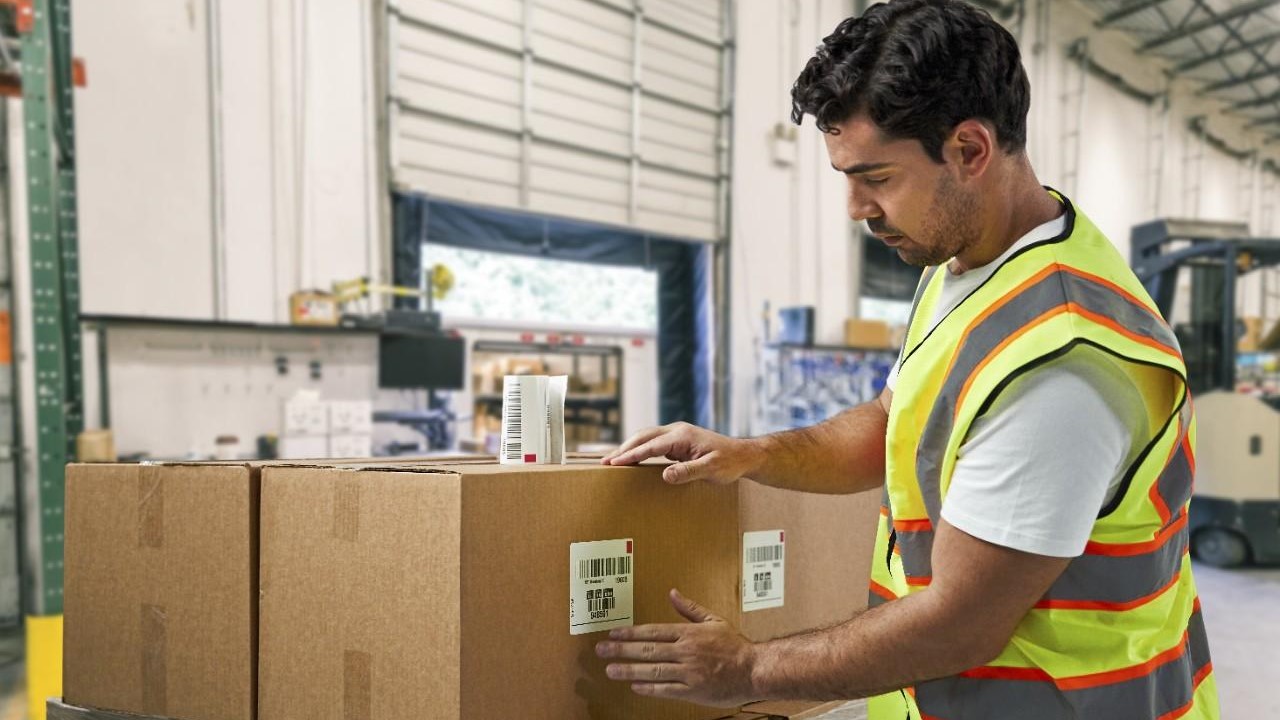
Remembering the Man Who Barcoded the World: A Tribute to George J. Laurer
Editor's Note: This post originally published in December 2019 and was updated in June 2024 and again in September 2024..
###
When George J. Laurer passed away in 2019, the world mourned. Though you may not recognize his name, you most certainly will recognize his legacy: the barcode.
Barcoding the World
In our daily lives, most of us hardly give the barcode a second thought. We may interact with it when we’re shopping and even then, it is merely the “bunch of lines and spaces” that helps us process the transaction and buy an item. Most think that the purpose of this black and white mark is, well, black and white.
But the barcode is so much more than that. The barcode powers everything from shopping to dining out, our healthcare, and even the logistics of delivering your many online orders to the right place at the right time (and tracking them along the way). It is estimated that the barcode is used on trillions of products worldwide, and this number continues to increase as more products and services are being created.
While this might sound like an over exaggeration, it is not. The barcode, from its humble beginnings, has become one of the most essential tools of modern life. The famous song lyric tells us that, “money makes the world go ‘round,” but in our current, always-on and connected world, it is in fact the barcode.
We can thank George for that.
We at Zebra are especially grateful for George’s innovative thinking and persistence. It is because of George that Zebra was founded over 50 years ago and why we are still here today, helping customers around the world in every industry make a mark on society via barcode-based solutions.
Fast Moving Consumer Barcodes
The Universal Product Code (UPC) that George designed, the one used today, is very different than the circular bulls-eye barcode originally introduced by Joseph Woodland. However, George's adaptation, the vertical black and white “zebra” barcode first trialed in a Kroger U.S. grocery store in the 1960s, opened the door for the barcode’s inclusion in everyday life.
Since then, the barcode has taken over retail and transformed how we shop. It still does the job it did back then, being affixed to products and making it easy for cashiers to process items for customers. Today, it is even more efficient. Cashiers can still use multi-plane, fixed grocery scanners to read barcodes, and store clerks can also be more mobile and offer scanning facilities throughout the store with handheld scanning devices.
In fact, one large U.S. supermarket chain is doing this...and more. It is transitioning from the traditional 1D barcode made up of lines and spaces and moving to 2D barcodes made up of many small, individual dots in square shapes and scanners to embed additional data. This ensures accurate data capture while enhancing store productivity and efficiency. (As part of this shift, the supermarket chain is also deploying Zebra data capture, mobile computing and printing solutions to increase store associate productivity and improve the customer experience..)
New barcodes, produced by U.S. company Digimarc, cover the entire packaging of the product, making the struggle to scan an item a thing of the past. The company has already implemented its innovative new scanning technology in two American stores. Developing this further, Digimarc scannable packaging will save time during checkout.
However, it doesn’t stop there. Retail establishments of all sorts are now working on even more innovative ways to make shopping more efficient and effective for store assistants and more enjoyable for customers. In doing so, customers are now given the ability to use their own mobile devices or handheld scanners to peruse the store at their own leisure and “shop as they go”.
This personal shopping capability allows customers to scan barcodes independently and also tracks their in-store location, offering them discounts based on previous purchases, directing them to their favorite items and even alerting them of potential harmful allergy risks in certain items. In the future, barcodes could be completely removed from shelf labels and instead replaced by “scannable” packaging.
From Store to Warehouse
The barcode also has a profound impact on how food and other items are transported worldwide, beyond how the items are purchased in store.
Of course, the logistical journey starts in the warehouse. By using barcode-enabled technology such as handheld and wearable scanners, warehouse staff can pick, pack, locate, maneuver, store and ship items more efficiently and effectively. Fixed industrial scanners also assist with the verification of a barcoded label's accuracy and proper placement in fast-moving print-and-apply workflows.
It’s not just about the hardware, though. Software is crucial to make warehouse management more agile. What is needed is a solution that complements the hardware to ensure all collected data is actioned properly.
But, just as the product leaves the warehouse, so too does a manufacturer’s influence. Field operatives on the road must still deliver the best service, and to do so they need tools that can give them visibility across field associates, customers, goods and assets. Without this insight, any gains seen within an organization’s four walls are immediately lost. Therefore, on-the-road proof of delivery, collection and fleet management are crucial to maintaining these high standards.
With rugged handheld mobile computers, scanners or tablets in hand, field-based team members are able to scan barcoded goods as they change hands to allow for delivery and collection tracking. These devices can also be used by drivers to communicate back to base, responding to all enquires and providing regular updates.
The Best in Health, Bar None
In hospitals and the pharmaceutical sector, the barcode is enhancing processes.
Even today, many healthcare systems still rely on handwritten documents which can lead to mistakes stemming from illegible handwriting and fading ink. This is where the barcode brings multiple benefits.
Instead of using paper and pen to manually document treatment, barcodes and scanners can be implemented along with a patient identity management solution to accurately and quickly match patients to their records, medication and treatments. This ensures mistakes are kept to a minimum, while patients receive the right care. And this is just one example of its many benefits in patient care.
The barcode is also used to monitor the health of the institution itself. From physical assets like an MRI machine to the staff, it can help enhance real-time data sharing and analytics, making the facility even more efficient and effective.
Each year, hundreds of thousands of deaths worldwide are attributed to the sale and subsequent consumption of counterfeit medicines. No country is immune from this scourge. But, thanks to a unique identification code, specific to each unit being sold, the origin and composition of a product could easily be ascertained. Using a basic 2D barcode flash, distributors will be able to follow their listed products in real time anywhere in the world. In the example of a bacterial contamination, distributors can react quickly to prevent it from reaching consumers.
Again, though, this is just one benefit that 2D barcodes will bring to healthcare providers, supply chain partners, and patients. You can hear about several others in this discussion between a clinician/technologist and GS1 Singapore representative here:
This is How 2D Barcodes Can (and Should) Be Used in Healthcare Settings
Track and Trace
The barcode is also playing a crucial role across industry in tracking and tracing items by knowing the location of any item in the world. This is something every organization needs now, to include utility service providers, government agencies, healthcare providers, sports clubs, and entertainment providers in addition to retailers, manufacturers, shippers, and distributors.
For example, to help fight the continuing rise in counterfeiting and counteract the illicit tobacco trade, the European Union (alongside other independent states) has ratified the Tobacco Products Directive, which enforces new obligations throughout the entire tobacco supply chain, significantly changing how it currently operates. The law now requires everyone involved in the manufacture and distribution of tobacco products to implement measures such as security features and traceability systems to achieve compliance across their supply chains.
In the healthcare sector, more than 400,000 pharmacies in Europe were impacted by the recently-enacted Falsified Medicines Directive to outlaw fake and illegal medication floating through the supply chain. Under the European Union (EU) Directive, safety features must be placed on individual packs so that they can be identified and authenticity is guaranteed. These also allow pharmacists to check if the outer packaging has been tampered with. The intent of this measure is to prevent the introduction of illegal medicine into the legal supply chain. This means pharmaceutical industry players must consolidate their medicine traceability practices to fight a rise in counterfeiting.
Thanks to a unique identification code, specific to each unit, the origin and composition of a product can easily be ascertained. Using a basic 2D barcode flash, distributors are able to follow their listed products in real time anywhere in the world. And that's just one of the many benefits of unique device identifiers (UDI) in healthcare.
George’s Legacy Will Live On
Clearly, the barcode has come a long way since its humble beginnings, transforming practically every industry that we rely on today. And, with more products and services being launched every day, it is clear the barcode will continue its crucial role to track and monitor, becoming even more indispensable.
As for the future, the barcode is here to stay. Its journey is not even a century old and we have seen such innovative and life-saving developments that its value will only increase, being critical to the success of global industries and re-writing the future in lines, small squares, radio frequencies and much more.
So, the next time you see (or benefit) from a barcode, take a moment to remember George and the incredible mark he has left on the world.
###
Related stories:
- Back to Basics: How to Use a Barcode to Automate Data Capture, Positive Patient ID and More in Healthcare Settings
- Why It's Wrong to Think of RFID as a Barcode Replacement
- #ThrowbackThursday: Meet the Zebra (and AIDC Industry Legend) Who Designed the First Handheld Scanner and the Scanner You Probably Have in Your Hand Right Now
- Industrial Automation Insider: Which is the Best Choice for Track and Trace, Quality Control, Loss Prevention and More: A Barcode, RFID or Vision System?
- U.S. Ergonomics (and Three Other Scanning Experts) Just Explained Why Front-Line Workers Favor Enterprise-Grade Mobile Computers Over Consumer Smartphones for Barcode Scanning

Zebra’s “Your Edge” Blog Team
The “Your Edge” Blog Team is comprised of content curators and editors from Zebra’s Global PR, Thought Leadership and Advocacy team. Our goal is to connect you with the industry experts best-versed on the issues, trends and solutions that impact your business. We will collectively deliver critical news analysis, exclusive insights on the state of your industry, and guidance on how your organization can leverage a number of different proven technology platforms and strategies to capture your edge.






